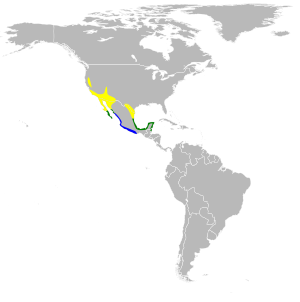Hooded oriole facts for kids
Quick facts for kids Hooded oriole |
|
|---|---|
 |
|
| Conservation status | |
| Scientific classification | |
 |
|
| Breeding range Year-round range Wintering range |
The hooded oriole (Icterus cucullatus) is a medium-sized bird from the oriole family. Male hooded orioles are usually bright orange or a lighter yellow. They have a black back, face, tail, and a black patch on their chest. Their wings have two white stripes. Female orioles are more olive-colored with some yellow.
Contents
About the Hooded Oriole
Adult hooded orioles have a curved, all-black beak and white bars on their wings. The male has a deep yellowish-orange head with black on its face and throat. Its back, wings, and tail are black, while its belly is orange. The female is olive-green on top and yellowish on her chest and belly. These birds make whistling sounds and "wheets." Their song is a mix of these sounds.
Hooded orioles like to live in open areas with trees, especially palm trees. They are found in the Southwestern United States and northern Mexico. Their nest is like a tightly woven bag. They attach it to the bottom of a leaf or a tree branch. Sometimes, another bird called a Brown-headed cowbird lays its eggs in the oriole's nest. The cowbird is a "parasite bird" because it makes other birds raise its young.
These birds migrate (travel) in groups to the southwestern coast of Mexico for winter. Some hooded orioles live all year in Baja California Sur, the east coast of Mexico, and Belize. A few might stay near bird feeders during winter. You can also find them in Southern California neighborhoods, but they are rare there in the colder months.
Hooded orioles look for food in trees and bushes. They also eat from flowers. They are known as "nectar robbers" because they poke a hole in the bottom of a flower. This lets them drink the nectar without helping the flower with pollination. These birds mostly eat insects, nectar, and fruit. They also visit hummingbird feeders and bird feeders for seeds.
Behavior and Habits
What They Eat
The hooded oriole's diet includes insects, berries, and nectar. They are very good at moving around while feeding. They often hang upside down to get nectar from flowers or to catch insects. They eat many kinds of insects, especially caterpillars, beetles, wasps, and ants.
Hooded orioles search for food slowly. They pick insects off leaves in trees and eat berries. Sometimes, they also eat oranges or other citrus fruits. They poke into flowers for nectar and might find insects there too. They often visit feeders that offer insects or hummingbird food.
Their Calls and Songs
The song of the hooded oriole is usually short and quick. The sounds are fast and don't have the long whistling notes of many other orioles. Their songs often sound a bit like a nasal whine.
The songs of hooded orioles can be very different depending on where they live and even between individual birds. Each male can sing many different types of songs. Hooded orioles have been known to copy the songs of other birds. For example, some in Arizona have copied the Gila Woodpecker and the Ash-throated Flycatcher.
Common calls include a whistled "wheet" or "sweet" sound. They make a chattering sound when they are alarmed. This chatter is a bit like the Baltimore Oriole or Bullock's Oriole. However, the hooded oriole's chatter notes are faster, making a shriller sound. Young orioles often make a soft "chut" and a harsher "chuck" or "chet." Adults have been heard making these sounds too.
Nesting and Young Birds
Male hooded orioles arrive at their nesting spots in late March. They set up areas where they will breed. The breeding season is from April to July in Texas, May to August in Arizona, and April to mid-August in California. In Baja California, it's from May to August.
Recent reports show that nests are built and attached to the underside of palm and banana plant leaves. The materials and location of nests can change depending on the area. Nests in Arizona are often made of grasses and found in taller trees. California nests are made from palm fibers and are on the underside of palm plants. The hooded oriole's nest is shaped like a basket and is much deeper than nests of its relatives.
Female hooded orioles lay a group of 3 to 5 eggs. The eggs are usually white but can be a pale blue with darker spots. The eggs are kept warm for 12 to 14 days until they hatch. The baby birds stay in the nest for about 14 days before they are ready to fly. As mentioned before, this species is often affected by Brown-headed cowbirds and Bronzed Cowbirds laying their eggs in their nests.
Different Types of Hooded Orioles
There are five slightly different types (called subspecies) of hooded orioles. They are divided into two main groups. One group lives east of the Big Bend area in Texas and is more orange. The other group lives in New Mexico and further south, and these birds are more yellow. These differences show how birds adapt to their local environments.
Images for kids
See also
 In Spanish: Turpial enmascarado para niños
In Spanish: Turpial enmascarado para niños





